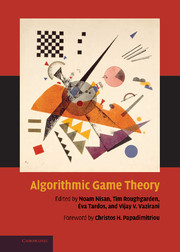Book contents
- Frontmatter
- Contents
- Foreword
- Preface
- Contributors
- I Computing in Games
- II Algorithmic Mechanism Design
- 9 Introduction to Mechanism Design (for Computer Scientists)
- 10 Mechanism Design without Money
- 11 Combinatorial Auctions
- 12 Computationally Efficient Approximation Mechanisms
- 13 Profit Maximization in Mechanism Design
- 14 Distributed Algorithmic Mechanism Design
- 15 Cost Sharing
- 16 Online Mechanisms
- III Quantifying the Inefficiency of Equilibria
- IV Additional Topics
- Index
16 - Online Mechanisms
from II - Algorithmic Mechanism Design
Published online by Cambridge University Press: 31 January 2011
- Frontmatter
- Contents
- Foreword
- Preface
- Contributors
- I Computing in Games
- II Algorithmic Mechanism Design
- 9 Introduction to Mechanism Design (for Computer Scientists)
- 10 Mechanism Design without Money
- 11 Combinatorial Auctions
- 12 Computationally Efficient Approximation Mechanisms
- 13 Profit Maximization in Mechanism Design
- 14 Distributed Algorithmic Mechanism Design
- 15 Cost Sharing
- 16 Online Mechanisms
- III Quantifying the Inefficiency of Equilibria
- IV Additional Topics
- Index
Summary
Abstract
Online mechanisms extend the methods of mechanism design to dynamic environments with multiple agents and private information. Decisions must be made as information about types is revealed online and without knowledge of the future, in the sense of online algorithms. We first consider single-valued preference domains and characterize the space of decision policies that can be truthfully implemented in a dominant strategy equilibrium. Working in a model-free environment, we present truthful auctions for domains with expiring items and limited-supply items. Turning to a more general preference domain, and assuming the existence of a probabilistic model for agent types, we define a dynamic Vickrey–Clarke–Groves mechanism that is efficient and Bayes–Nash incentive compatible. We close with some thoughts about future research directions in this area.
Introduction
The decision problem in many multiagent problem domains is inherently dynamic rather than static. Consider, for instance, the following environments:
Selling seats on an airplane to buyers arriving over time.
Allocating computational resources (bandwidth, CPU, etc.) to jobs arriving over time.
Selling adverts on a search engine to a possibly changing group of buyers and with uncertainty about the future supply of search terms.
Allocating tasks to a dynamically changing team of agents.
In each of these settings at least one of the following is true: either agents are dynamically arriving or departing, or there is uncertainty about the set of feasible decisions in the future.
Information
- Type
- Chapter
- Information
- Algorithmic Game Theory , pp. 411 - 440Publisher: Cambridge University PressPrint publication year: 2007
Accessibility standard: Unknown
Why this information is here
This section outlines the accessibility features of this content - including support for screen readers, full keyboard navigation and high-contrast display options. This may not be relevant for you.Accessibility Information
- 44
- Cited by
